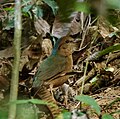| Image | Scientific name | Common name | Distribution |
|---|
| Hydrornis phayrei | Eared pitta | Southeast Asia. |
 | Hydrornis nipalensis | Blue-naped pitta | Bangladesh, Bhutan, China, India, Laos, Myanmar, Nepal, and Vietnam. |
 | Hydrornis soror | Blue-rumped pitta | Cambodia, China, Laos, Thailand, and Vietnam |
 | Hydrornis oatesi | Rusty-naped pitta | China, Laos, Malaysia, Myanmar, Thailand, and Vietnam. |
 | Hydrornis schneideri | Schneider's pitta | Sumatra in Indonesia |
 | Hydrornis caeruleus | Giant pitta | Brunei, Indonesia, Malaysia, Myanmar, and Thailand. |
 | Hydrornis baudii | Blue-headed pitta | Borneo |
 | Hydrornis cyaneus | Blue pitta | Bangladesh, Bhutan, Cambodia, India, Laos, Myanmar, Thailand, and Vietnam. |
 | Hydrornis elliotii | Bar-bellied pitta | Cambodia, Laos, Thailand, and Vietnam |
 | Hydrornis gurneyi | Gurney's pitta | Malay Peninsula |
 | Hydrornis guajanus | Javan banded pitta | Java and Bali |
 | Hydrornis irena | Malayan banded pitta | Thailand, the Malay Peninsula and Sumatra. |
 | Hydrornis schwaneri | Bornean banded pitta | Borneo |
|













